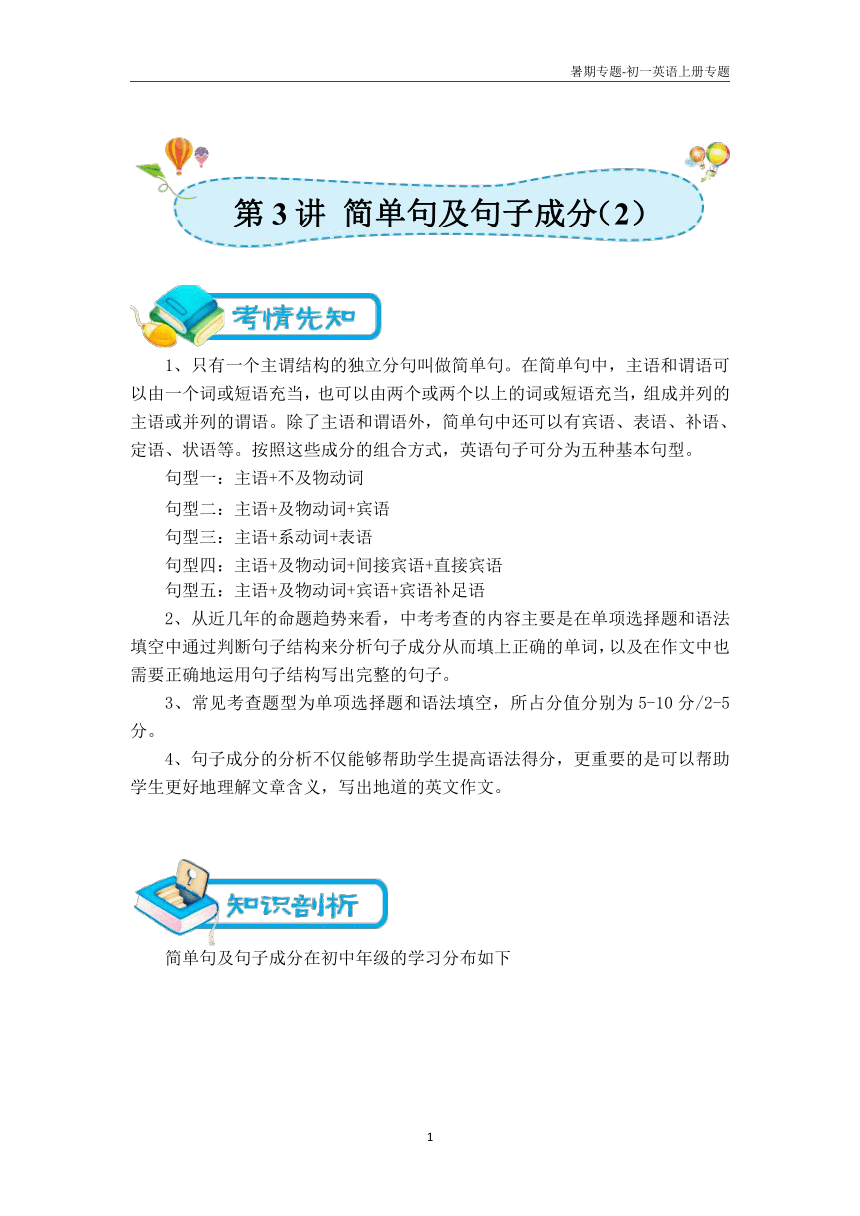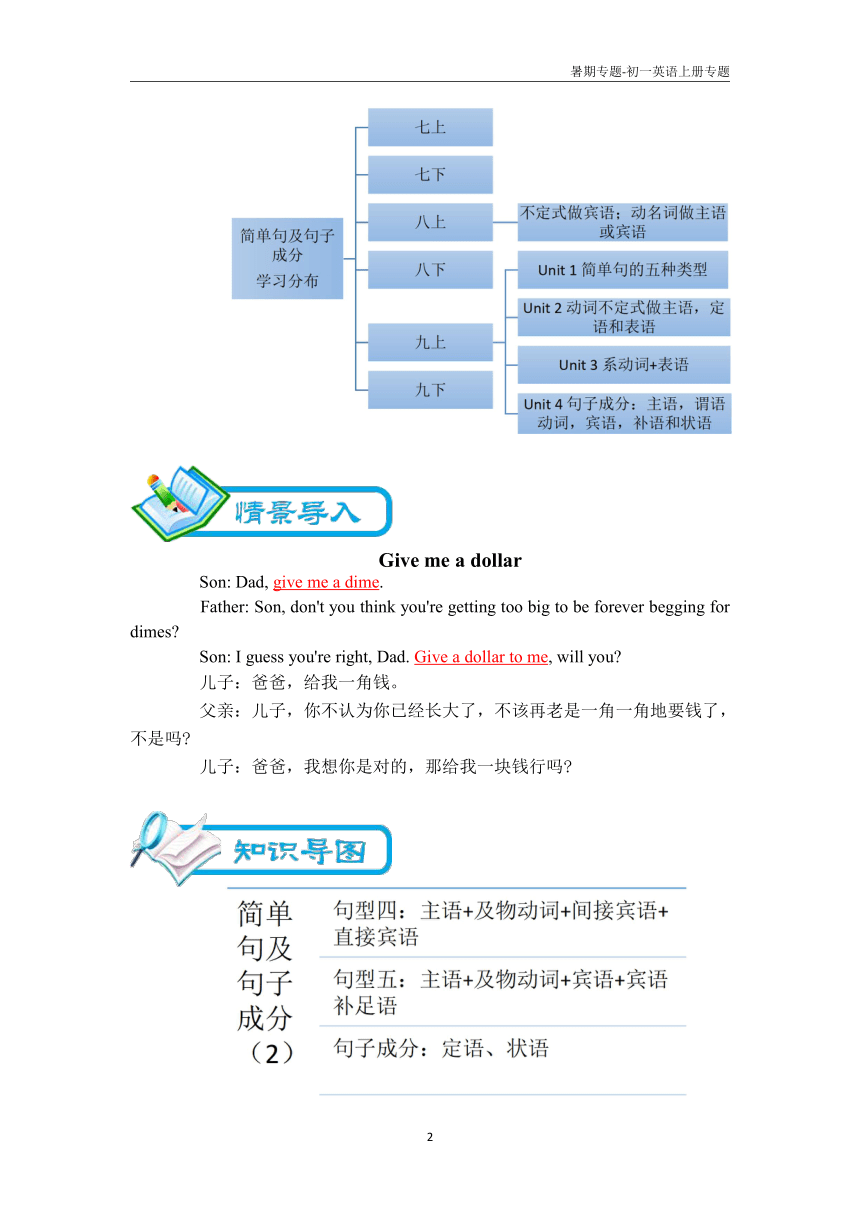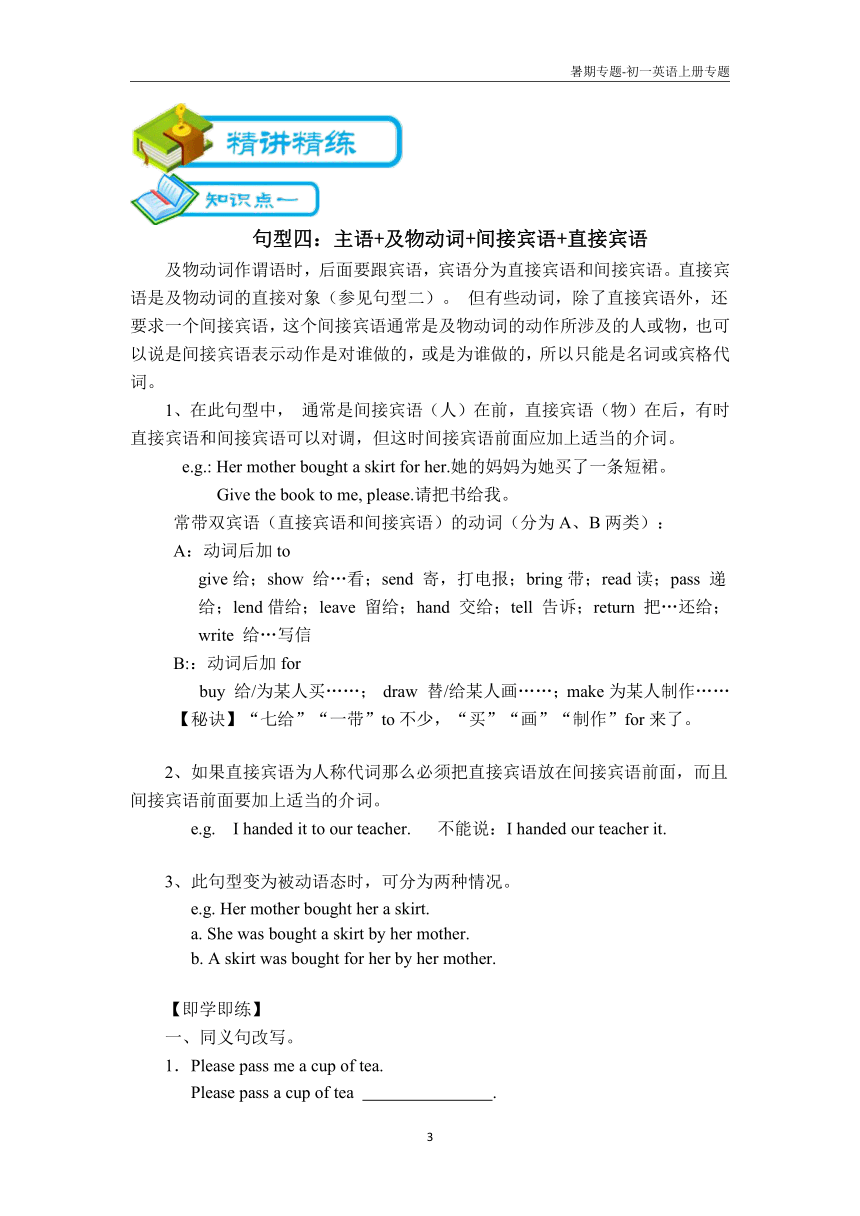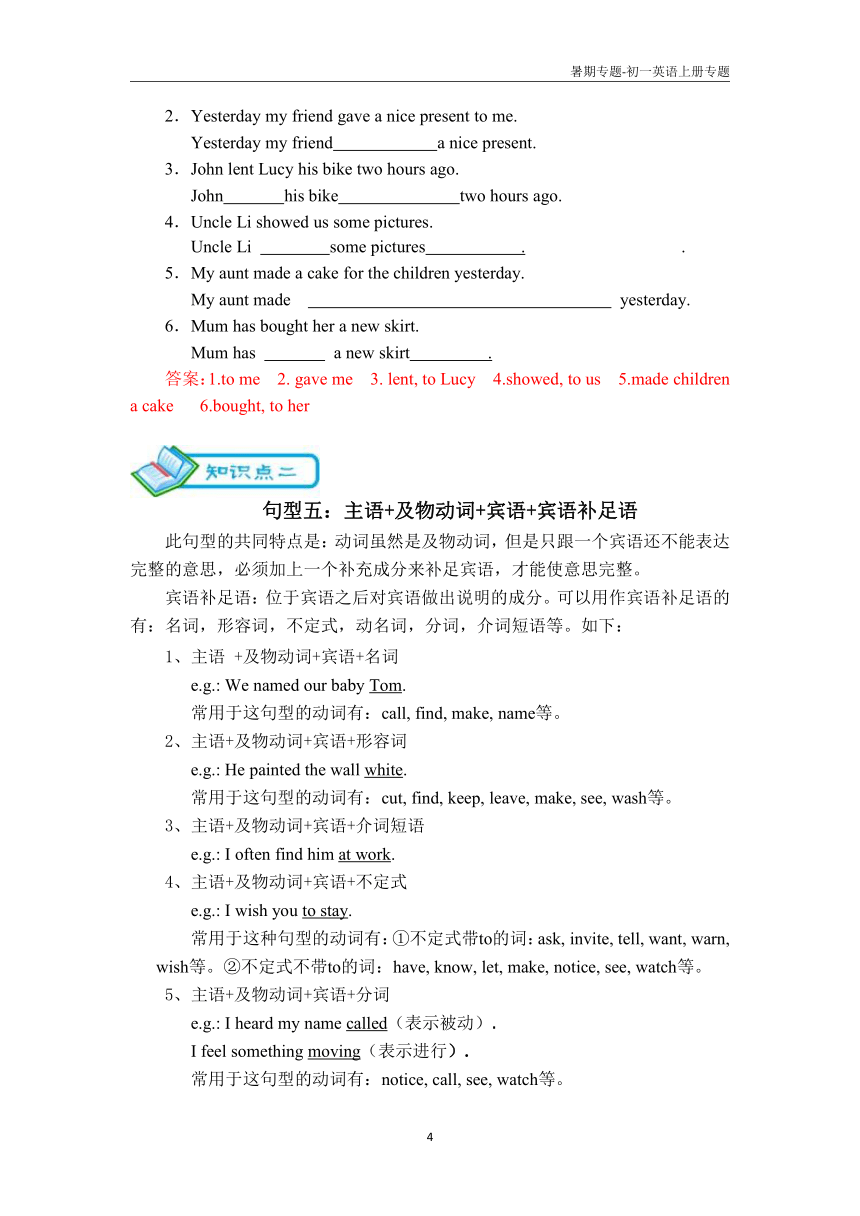【沪教牛津版】【暑期课程初一上英语专题】【第3讲 简单句及句子成分】讲义(含答案)
文档属性
| 名称 | 【沪教牛津版】【暑期课程初一上英语专题】【第3讲 简单句及句子成分】讲义(含答案) |  | |
| 格式 | zip | ||
| 文件大小 | 228.6KB | ||
| 资源类型 | 教案 | ||
| 版本资源 | 牛津深圳版 | ||
| 科目 | 英语 | ||
| 更新时间 | 2021-05-21 10:54:41 | ||
图片预览




文档简介
暑期专题-初一英语上册专题
1、只有一个主谓结构的独立分句叫做简单句。在简单句中,主语和谓语可以由一个词或短语充当,也可以由两个或两个以上的词或短语充当,组成并列的主语或并列的谓语。除了主语和谓语外,简单句中还可以有宾语、表语、补语、定语、状语等。按照这些成分的组合方式,英语句子可分为五种基本句型。
句型一:主语+不及物动词
句型二:主语+及物动词+宾语
句型三:主语+系动词+表语
句型四:主语+及物动词+间接宾语+直接宾语
句型五:主语+及物动词+宾语+宾语补足语
2、从近几年的命题趋势来看,中考考查的内容主要是在单项选择题和语法填空中通过判断句子结构来分析句子成分从而填上正确的单词,以及在作文中也需要正确地运用句子结构写出完整的句子。
3、常见考查题型为单项选择题和语法填空,所占分值分别为5-10分/2-5分。
4、句子成分的分析不仅能够帮助学生提高语法得分,更重要的是可以帮助学生更好地理解文章含义,写出地道的英文作文。
简单句及句子成分在初中年级的学习分布如下
Give
me
a
dollar
Son:
Dad,
give
me
a
dime.
Father:
Son,
don't
you
think
you're
getting
too
big
to
be
forever
begging
for
dimes?
Son:
I
guess
you're
right,
Dad.
Give
a
dollar
to
me,
will
you?
儿子:爸爸,给我一角钱。
父亲:儿子,你不认为你已经长大了,不该再老是一角一角地要钱了,不是吗?
儿子:爸爸,我想你是对的,那给我一块钱行吗?
句型四:主语+及物动词+间接宾语+直接宾语
及物动词作谓语时,后面要跟宾语,宾语分为直接宾语和间接宾语。直接宾语是及物动词的直接对象(参见句型二)。
但有些动词,除了直接宾语外,还要求一个间接宾语,这个间接宾语通常是及物动词的动作所涉及的人或物,也可以说是间接宾语表示动作是对谁做的,或是为谁做的,所以只能是名词或宾格代词。
1、在此句型中,
通常是间接宾语(人)在前,直接宾语(物)在后,有时直接宾语和间接宾语可以对调,但这时间接宾语前面应加上适当的介词。
e.g.:
Her
mother
bought
a
skirt
for
her.她的妈妈为她买了一条短裙。
Give
the
book
to
me,
please.请把书给我。
常带双宾语(直接宾语和间接宾语)的动词(分为A、B两类):
A:动词后加to
give给;show
给…看;send
寄,打电报;bring带;read读;pass
递给;lend借给;leave
留给;hand
交给;tell
告诉;return
把…还给;write
给…写信
B::动词后加for
buy
给/为某人买……;
draw
替/给某人画……;make为某人制作……
【秘诀】“七给”“一带”to不少,“买”“画”“制作”for来了。
2、如果直接宾语为人称代词那么必须把直接宾语放在间接宾语前面,而且间接宾语前面要加上适当的介词。
e.g.
I
handed
it
to
our
teacher.
不能说:I
handed
our
teacher
it.
3、此句型变为被动语态时,可分为两种情况。
e.g.
Her
mother
bought
her
a
skirt.
a.
She
was
bought
a
skirt
by
her
mother.
b.
A
skirt
was
bought
for
her
by
her
mother.
【即学即练】
一、同义句改写。
1.Please
pass
me
a
cup
of
tea.
Please
pass
a
cup
of
tea
.
2.Yesterday
my
friend
gave
a
nice
present
to
me.
Yesterday
my
friend
a
nice
present.
3.John
lent
Lucy
his
bike
two
hours
ago.
John
his
bike
two
hours
ago.
Uncle
Li
showed
us
some
pictures.
Uncle
Li
some
pictures
.
.
5.My
aunt
made
a
cake
for
the
children
yesterday.
My
aunt
made
yesterday.
6.Mum
has
bought
her
a
new
skirt.
Mum
has
a
new
skirt
.
答案:1.to
me
2.
gave
me
3.
lent,
to
Lucy
4.showed,
to
us
5.made
children
a
cake
6.bought,
to
her
句型五:主语+及物动词+宾语+宾语补足语
此句型的共同特点是:动词虽然是及物动词,但是只跟一个宾语还不能表达完整的意思,必须加上一个补充成分来补足宾语,才能使意思完整。
宾语补足语:位于宾语之后对宾语做出说明的成分。可以用作宾语补足语的有:名词,形容词,不定式,动名词,分词,介词短语等。如下:
1、主语
+及物动词+宾语+名词
e.g.:
We
named
our
baby
Tom.
常用于这句型的动词有:call,
find,
make,
name等。
2、主语+及物动词+宾语+形容词
e.g.:
He
painted
the
wall
white.
常用于这句型的动词有:cut,
find,
keep,
leave,
make,
see,
wash等。
3、主语+及物动词+宾语+介词短语
e.g.:
I
often
find
him
at
work.
4、主语+及物动词+宾语+不定式
e.g.:
I
wish
you
to
stay.
常用于这种句型的动词有:①不定式带to的词:ask,
invite,
tell,
want,
warn,
wish等。②不定式不带to的词:have,
know,
let,
make,
notice,
see,
watch等。
5、主语+及物动词+宾语+分词
e.g.:
I
heard
my
name
called(表示被动).
I
feel
something
moving(表示进行).
常用于这句型的动词有:notice,
call,
see,
watch等。
6、主语+及物动词+宾语+疑问词+不定式
e.g.:
He
shows
me
how
to
do
it.
常用于这句型的动词有:ask,
show,
teach,
tell等。
【秘
诀】
不定式,作宾补,下列词后省去to:
四“看见”,三“使役”,二“听”,一“感”,
半“帮助”;
保你永远会记住。
【说
明】
“半帮助”指help,可以带也可以不带to;“一感”指feel;“二听”指hear,
listen
to;三个“小使役”指have,
let,
make三个使役动词;“四看见”指notice,
observe,
see,
watch;在这些动词后有不定式作宾补时,不定式的符号to往往要省去。
注意:在这个结构中,可以出现用it做形式上的宾语,把真正的宾语放在宾语补足语的后面。在此结构中,宾语常常是动词不定式或宾语从句。
1.
He
felt
it
his
duty
to
mention
this
to
her.
分析:it是形式宾语,his
duty是宾语补足语,to
mention
this
to
her是真正的宾语。
2.
I
think
it
best
that
you
should
stay
with
us.
分析:it是形式宾语,best是宾语补足语,that
you
should
stay
with
us是真正的宾语。
【即学即练】
一、请划出下列句子的宾语补足语并说明是哪种类型。
1.
The
loud
voice
from
the
upstairs
made
him
angry.
2.
Will
you
tell
us
an
exciting
story?
3.
We
must
keep
our
classroom
tidy
and
clean.
4.
I
heard
the
baby
crying
in
the
sitting
room.
5.
Can
you
push
the
window
open?
答案:1.
angry(形容词);
2.an
exciting
story(名词短语);
3.tidy
and
clean(形容词);
4.crying(现在分词);
5.open(形容词)
句子修饰成分
一、定语:定语是对名词或代词起修饰、限定作用的词、短语或句子,汉语中常用“......的”表示。
定语通常位于被修饰的成分前,若修饰some,
any,
every,
no构成的复合不定代词时(如:something、nothing),或不定式、分词短语作定语、从句作定语时,则定语通常置后,副词用作定语时须放在名词之后。
Yang
Ling
is
a
chemistry
teacher.(名词)
He
is
our
friend.
(代词)
We
belong
to
the
third
world.(数词)
He
was
advised
to
teach
the
lazy
boy
a
lesson.(形容词)
The
man
over
there
is
my
old
friend.(副词)
The
woman
with
a
baby
in
her
arms
is
my
sister.
(介词)
The
boys
playing
football
are
in
Class
2.
(现在分词)
The
trees
planted
last
year
are
growing
well
now.
(过去分词)
I
have
an
idea
to
do
it
well.(不定式)
You
should
do
everything
that
I
do.
(定语从句)
二、状语:用来修饰动词,形容词,副词或句子;表示时间、地点、原因、目的、结果、程度、条件、方式和让步。(以下例句按上述顺序排列)
I
will
go
there
tomorrow.
The
meeting
will
be
held
in
the
meeting
room.
The
meat
went
bad
because
of
the
hot
weather.
He
studies
hard
to
learn
English
well.
He
didn’t
study
hard
so
that
he
failed
in
the
exam.
I
like
some
of
you
very
much.
If
you
study
hard,
you
will
pass
the
exam.
He
goes
to
school
by
bike.
Though
he
is
young,
he
can
do
it
well.
【秘
诀】划分句子的口诀:
(1)句子成分要划对
(2)纵观全局找主谓
(3)主前定状谓后补
(4)谓前只有状地位
(5)“的”定“地”状“得”后补
(6)宾语只受谓支配
【即学即练】
一、
划出下列句子中的定语。
1.
They
use
Mr.,
Mrs.
with
the
family
name.
2.
What
is
your
given
name?
3.
On
the
third
lap
are
Class
1
and
Class
3.
4.
I
am
afraid
some
people
forgot
to
sweep
the
floor.
5.
The
man
downstairs
was
trying
to
sleep.
6.
I
am
waiting
for
the
sound
of
the
other
shoe!
二、划出下列句子中的状语。
1.
There
was
a
big
smile
on
her
face.
2.
Every
night
he
heard
the
noise
upstairs.
3.
He
began
to
learn
English
when
he
was
eleven.
4.
The
man
on
the
motorbike
was
travelling
too
fast.
5.
With
the
medicine
box
under
her
arm,
Miss
Li
hurried
off.
6.
She
loves
the
library
because
she
loves
books.
7.
I
am
afraid
that
if
you've
lost
it,
you
must
pay
for
it.
8.
The
students
followed
Uncle
Wang
to
see
the
other
machine.
答案:一、1.
family
2.
given
3.
third
4.
some
5.
downstairs
6.
of
the
other
shoe
二、1.
on
her
face
2.
Every
night
3.when
he
was
eleven
4.
too
fast
5.
With
the
medicine
box
under
her
arm
6.
because
she
loves
books
7.
if
you’ve
lost
it
8.
to
see
the
other
machine
简单句及句子成分之易错点
直接宾语和间接宾语的区分:直接宾语表示动作的承受者,一般是物。间接宾语表示动作是对谁或为谁做的,一般是人。
1、间接宾语可以改为由介词to或for引起的短语,放在直接宾语后面。
如:He
gave
her
some
chips.
=
He
gave
some
chips
to
her.
2、以下几种情况通常要用介词to或for引起的短语:
当直接宾语是人称代词(it/them)时。如:This
book
is
Mr.
Wang's.
Please
give
it
to
him.
当强调间接宾语时。如:Mother
cooks
meals
for
us
every
day.
3)
当间接宾语比直接宾语长一些时。如:On
the
bus,
she
often
gives
her
seat
to
the
old
person.
3、由to引出间接宾语的动词有:give,
show,
pass,
lend,
take,
tell等;由for引出间接宾语的动词有:buy,
make,
cook,
get,
sing,
read等。
【即学即练】
一、翻译。
1.?这个学期我已经给父母写过三封信了。
2.?我父亲已经给我买了一辆新自行车。
??
3.
Robinson
Crusoe?给自己做了一只小船。
4.?请你给我弄一本新的,好吗?
??
5.?我替你叫辆出租汽车好吗?
答案:
1.
This
term
I
have
written
three
letters
to
my
parents.
My
father
has
bought
me
a
new
bike.
Robinson
Crusoe
made
himself
a
boat.
Will
you
please
get
me
a
new
copy?
Shall
I
call
you
a
taxi?
一、指出下列各句属于哪种基本句型。
1.They
are
students.
(
)
2.The
flowers
turn
red
in
spring.
(
)
3.The
boys
laughed.
(
)
4.We
study
English.
(
)
5.The
teacher
asked
me
two
questions.
(
)
6.We
all
call
him
Li.
(
)
答案:1.主系表
2.主系表
3.主谓
4.主谓宾
5.主谓宾,双宾语
6.主谓宾,宾补
二、分析下列句子成分。
1.
Our
school
is
not
far
from
my
home.
????????
?
2.
It
is
a
great
pleasure
to
talk
with
you
3.
All
of
us
considered
him
honest.
?????????
4.
My
grandfather
bought
me
a
pair
of
sports
shoes.
5.
He
broke
a
piece
of
glass.
?????????
6.
He
made
it
clear
that
he
would
leave
the
city.
7.
---I
love
you
more
than
her,child?.
?????
8.
Tees
turn
green
when
spring
comes.
9.
They
pushed
the
door
open.
??????????
10.
Grandma
told
me
an
interesting
story
last
night.
11.
He
wrote
carefully
some
letters
to
his
friends.
??
12.All
the
students
think
highly
of
his
teaching
?www.
13.
We
need
a
place
twice
larger
than
this
one.
???
?
14.
He
asked
us
to
sing
an
English
song.
15.
Don't
get
nervous,help
yourself
to
what
you
like.
答案:
1.主语+系动词+表语
????
2.主语+系动词+表语
?
3.主语+动词+宾语+宾语补足语
?
4.主语+双宾动词+间接宾语+直接宾语
???
5.主语+及物动词+宾语
????
6.主语+动词+形式宾语it+宾语补足语+宾语
7.主语+及物动词+宾语
????
8.主语+系动词+表语
??
9.主语+动词+宾语+宾语补足语
?
10.
主语+双宾动词+间接宾语+直接宾语
???
11.主语+双宾动词+间接宾语+直接宾语
?
12主语+及物动词+宾语
13.主语+及物动词+宾语
????
14.主语+动词+宾语+宾语补足语
??
15.主语+系动词+表语
????
总结
句型四
主语+及物动词+
+
句型五
主语+及物动词+
+
句子修饰成分
补语,定语,状语
学生易错点整理:
_______________________________________________________________________________________________________________________________________________________________________________________________________________________________________________________________________________________________________________________________________________________________________________________________________
1
1、只有一个主谓结构的独立分句叫做简单句。在简单句中,主语和谓语可以由一个词或短语充当,也可以由两个或两个以上的词或短语充当,组成并列的主语或并列的谓语。除了主语和谓语外,简单句中还可以有宾语、表语、补语、定语、状语等。按照这些成分的组合方式,英语句子可分为五种基本句型。
句型一:主语+不及物动词
句型二:主语+及物动词+宾语
句型三:主语+系动词+表语
句型四:主语+及物动词+间接宾语+直接宾语
句型五:主语+及物动词+宾语+宾语补足语
2、从近几年的命题趋势来看,中考考查的内容主要是在单项选择题和语法填空中通过判断句子结构来分析句子成分从而填上正确的单词,以及在作文中也需要正确地运用句子结构写出完整的句子。
3、常见考查题型为单项选择题和语法填空,所占分值分别为5-10分/2-5分。
4、句子成分的分析不仅能够帮助学生提高语法得分,更重要的是可以帮助学生更好地理解文章含义,写出地道的英文作文。
简单句及句子成分在初中年级的学习分布如下
Give
me
a
dollar
Son:
Dad,
give
me
a
dime.
Father:
Son,
don't
you
think
you're
getting
too
big
to
be
forever
begging
for
dimes?
Son:
I
guess
you're
right,
Dad.
Give
a
dollar
to
me,
will
you?
儿子:爸爸,给我一角钱。
父亲:儿子,你不认为你已经长大了,不该再老是一角一角地要钱了,不是吗?
儿子:爸爸,我想你是对的,那给我一块钱行吗?
句型四:主语+及物动词+间接宾语+直接宾语
及物动词作谓语时,后面要跟宾语,宾语分为直接宾语和间接宾语。直接宾语是及物动词的直接对象(参见句型二)。
但有些动词,除了直接宾语外,还要求一个间接宾语,这个间接宾语通常是及物动词的动作所涉及的人或物,也可以说是间接宾语表示动作是对谁做的,或是为谁做的,所以只能是名词或宾格代词。
1、在此句型中,
通常是间接宾语(人)在前,直接宾语(物)在后,有时直接宾语和间接宾语可以对调,但这时间接宾语前面应加上适当的介词。
e.g.:
Her
mother
bought
a
skirt
for
her.她的妈妈为她买了一条短裙。
Give
the
book
to
me,
please.请把书给我。
常带双宾语(直接宾语和间接宾语)的动词(分为A、B两类):
A:动词后加to
give给;show
给…看;send
寄,打电报;bring带;read读;pass
递给;lend借给;leave
留给;hand
交给;tell
告诉;return
把…还给;write
给…写信
B::动词后加for
buy
给/为某人买……;
draw
替/给某人画……;make为某人制作……
【秘诀】“七给”“一带”to不少,“买”“画”“制作”for来了。
2、如果直接宾语为人称代词那么必须把直接宾语放在间接宾语前面,而且间接宾语前面要加上适当的介词。
e.g.
I
handed
it
to
our
teacher.
不能说:I
handed
our
teacher
it.
3、此句型变为被动语态时,可分为两种情况。
e.g.
Her
mother
bought
her
a
skirt.
a.
She
was
bought
a
skirt
by
her
mother.
b.
A
skirt
was
bought
for
her
by
her
mother.
【即学即练】
一、同义句改写。
1.Please
pass
me
a
cup
of
tea.
Please
pass
a
cup
of
tea
.
2.Yesterday
my
friend
gave
a
nice
present
to
me.
Yesterday
my
friend
a
nice
present.
3.John
lent
Lucy
his
bike
two
hours
ago.
John
his
bike
two
hours
ago.
Uncle
Li
showed
us
some
pictures.
Uncle
Li
some
pictures
.
.
5.My
aunt
made
a
cake
for
the
children
yesterday.
My
aunt
made
yesterday.
6.Mum
has
bought
her
a
new
skirt.
Mum
has
a
new
skirt
.
答案:1.to
me
2.
gave
me
3.
lent,
to
Lucy
4.showed,
to
us
5.made
children
a
cake
6.bought,
to
her
句型五:主语+及物动词+宾语+宾语补足语
此句型的共同特点是:动词虽然是及物动词,但是只跟一个宾语还不能表达完整的意思,必须加上一个补充成分来补足宾语,才能使意思完整。
宾语补足语:位于宾语之后对宾语做出说明的成分。可以用作宾语补足语的有:名词,形容词,不定式,动名词,分词,介词短语等。如下:
1、主语
+及物动词+宾语+名词
e.g.:
We
named
our
baby
Tom.
常用于这句型的动词有:call,
find,
make,
name等。
2、主语+及物动词+宾语+形容词
e.g.:
He
painted
the
wall
white.
常用于这句型的动词有:cut,
find,
keep,
leave,
make,
see,
wash等。
3、主语+及物动词+宾语+介词短语
e.g.:
I
often
find
him
at
work.
4、主语+及物动词+宾语+不定式
e.g.:
I
wish
you
to
stay.
常用于这种句型的动词有:①不定式带to的词:ask,
invite,
tell,
want,
warn,
wish等。②不定式不带to的词:have,
know,
let,
make,
notice,
see,
watch等。
5、主语+及物动词+宾语+分词
e.g.:
I
heard
my
name
called(表示被动).
I
feel
something
moving(表示进行).
常用于这句型的动词有:notice,
call,
see,
watch等。
6、主语+及物动词+宾语+疑问词+不定式
e.g.:
He
shows
me
how
to
do
it.
常用于这句型的动词有:ask,
show,
teach,
tell等。
【秘
诀】
不定式,作宾补,下列词后省去to:
四“看见”,三“使役”,二“听”,一“感”,
半“帮助”;
保你永远会记住。
【说
明】
“半帮助”指help,可以带也可以不带to;“一感”指feel;“二听”指hear,
listen
to;三个“小使役”指have,
let,
make三个使役动词;“四看见”指notice,
observe,
see,
watch;在这些动词后有不定式作宾补时,不定式的符号to往往要省去。
注意:在这个结构中,可以出现用it做形式上的宾语,把真正的宾语放在宾语补足语的后面。在此结构中,宾语常常是动词不定式或宾语从句。
1.
He
felt
it
his
duty
to
mention
this
to
her.
分析:it是形式宾语,his
duty是宾语补足语,to
mention
this
to
her是真正的宾语。
2.
I
think
it
best
that
you
should
stay
with
us.
分析:it是形式宾语,best是宾语补足语,that
you
should
stay
with
us是真正的宾语。
【即学即练】
一、请划出下列句子的宾语补足语并说明是哪种类型。
1.
The
loud
voice
from
the
upstairs
made
him
angry.
2.
Will
you
tell
us
an
exciting
story?
3.
We
must
keep
our
classroom
tidy
and
clean.
4.
I
heard
the
baby
crying
in
the
sitting
room.
5.
Can
you
push
the
window
open?
答案:1.
angry(形容词);
2.an
exciting
story(名词短语);
3.tidy
and
clean(形容词);
4.crying(现在分词);
5.open(形容词)
句子修饰成分
一、定语:定语是对名词或代词起修饰、限定作用的词、短语或句子,汉语中常用“......的”表示。
定语通常位于被修饰的成分前,若修饰some,
any,
every,
no构成的复合不定代词时(如:something、nothing),或不定式、分词短语作定语、从句作定语时,则定语通常置后,副词用作定语时须放在名词之后。
Yang
Ling
is
a
chemistry
teacher.(名词)
He
is
our
friend.
(代词)
We
belong
to
the
third
world.(数词)
He
was
advised
to
teach
the
lazy
boy
a
lesson.(形容词)
The
man
over
there
is
my
old
friend.(副词)
The
woman
with
a
baby
in
her
arms
is
my
sister.
(介词)
The
boys
playing
football
are
in
Class
2.
(现在分词)
The
trees
planted
last
year
are
growing
well
now.
(过去分词)
I
have
an
idea
to
do
it
well.(不定式)
You
should
do
everything
that
I
do.
(定语从句)
二、状语:用来修饰动词,形容词,副词或句子;表示时间、地点、原因、目的、结果、程度、条件、方式和让步。(以下例句按上述顺序排列)
I
will
go
there
tomorrow.
The
meeting
will
be
held
in
the
meeting
room.
The
meat
went
bad
because
of
the
hot
weather.
He
studies
hard
to
learn
English
well.
He
didn’t
study
hard
so
that
he
failed
in
the
exam.
I
like
some
of
you
very
much.
If
you
study
hard,
you
will
pass
the
exam.
He
goes
to
school
by
bike.
Though
he
is
young,
he
can
do
it
well.
【秘
诀】划分句子的口诀:
(1)句子成分要划对
(2)纵观全局找主谓
(3)主前定状谓后补
(4)谓前只有状地位
(5)“的”定“地”状“得”后补
(6)宾语只受谓支配
【即学即练】
一、
划出下列句子中的定语。
1.
They
use
Mr.,
Mrs.
with
the
family
name.
2.
What
is
your
given
name?
3.
On
the
third
lap
are
Class
1
and
Class
3.
4.
I
am
afraid
some
people
forgot
to
sweep
the
floor.
5.
The
man
downstairs
was
trying
to
sleep.
6.
I
am
waiting
for
the
sound
of
the
other
shoe!
二、划出下列句子中的状语。
1.
There
was
a
big
smile
on
her
face.
2.
Every
night
he
heard
the
noise
upstairs.
3.
He
began
to
learn
English
when
he
was
eleven.
4.
The
man
on
the
motorbike
was
travelling
too
fast.
5.
With
the
medicine
box
under
her
arm,
Miss
Li
hurried
off.
6.
She
loves
the
library
because
she
loves
books.
7.
I
am
afraid
that
if
you've
lost
it,
you
must
pay
for
it.
8.
The
students
followed
Uncle
Wang
to
see
the
other
machine.
答案:一、1.
family
2.
given
3.
third
4.
some
5.
downstairs
6.
of
the
other
shoe
二、1.
on
her
face
2.
Every
night
3.when
he
was
eleven
4.
too
fast
5.
With
the
medicine
box
under
her
arm
6.
because
she
loves
books
7.
if
you’ve
lost
it
8.
to
see
the
other
machine
简单句及句子成分之易错点
直接宾语和间接宾语的区分:直接宾语表示动作的承受者,一般是物。间接宾语表示动作是对谁或为谁做的,一般是人。
1、间接宾语可以改为由介词to或for引起的短语,放在直接宾语后面。
如:He
gave
her
some
chips.
=
He
gave
some
chips
to
her.
2、以下几种情况通常要用介词to或for引起的短语:
当直接宾语是人称代词(it/them)时。如:This
book
is
Mr.
Wang's.
Please
give
it
to
him.
当强调间接宾语时。如:Mother
cooks
meals
for
us
every
day.
3)
当间接宾语比直接宾语长一些时。如:On
the
bus,
she
often
gives
her
seat
to
the
old
person.
3、由to引出间接宾语的动词有:give,
show,
pass,
lend,
take,
tell等;由for引出间接宾语的动词有:buy,
make,
cook,
get,
sing,
read等。
【即学即练】
一、翻译。
1.?这个学期我已经给父母写过三封信了。
2.?我父亲已经给我买了一辆新自行车。
??
3.
Robinson
Crusoe?给自己做了一只小船。
4.?请你给我弄一本新的,好吗?
??
5.?我替你叫辆出租汽车好吗?
答案:
1.
This
term
I
have
written
three
letters
to
my
parents.
My
father
has
bought
me
a
new
bike.
Robinson
Crusoe
made
himself
a
boat.
Will
you
please
get
me
a
new
copy?
Shall
I
call
you
a
taxi?
一、指出下列各句属于哪种基本句型。
1.They
are
students.
(
)
2.The
flowers
turn
red
in
spring.
(
)
3.The
boys
laughed.
(
)
4.We
study
English.
(
)
5.The
teacher
asked
me
two
questions.
(
)
6.We
all
call
him
Li.
(
)
答案:1.主系表
2.主系表
3.主谓
4.主谓宾
5.主谓宾,双宾语
6.主谓宾,宾补
二、分析下列句子成分。
1.
Our
school
is
not
far
from
my
home.
????????
?
2.
It
is
a
great
pleasure
to
talk
with
you
3.
All
of
us
considered
him
honest.
?????????
4.
My
grandfather
bought
me
a
pair
of
sports
shoes.
5.
He
broke
a
piece
of
glass.
?????????
6.
He
made
it
clear
that
he
would
leave
the
city.
7.
---I
love
you
more
than
her,child?.
?????
8.
Tees
turn
green
when
spring
comes.
9.
They
pushed
the
door
open.
??????????
10.
Grandma
told
me
an
interesting
story
last
night.
11.
He
wrote
carefully
some
letters
to
his
friends.
??
12.All
the
students
think
highly
of
his
teaching
?www.
13.
We
need
a
place
twice
larger
than
this
one.
???
?
14.
He
asked
us
to
sing
an
English
song.
15.
Don't
get
nervous,help
yourself
to
what
you
like.
答案:
1.主语+系动词+表语
????
2.主语+系动词+表语
?
3.主语+动词+宾语+宾语补足语
?
4.主语+双宾动词+间接宾语+直接宾语
???
5.主语+及物动词+宾语
????
6.主语+动词+形式宾语it+宾语补足语+宾语
7.主语+及物动词+宾语
????
8.主语+系动词+表语
??
9.主语+动词+宾语+宾语补足语
?
10.
主语+双宾动词+间接宾语+直接宾语
???
11.主语+双宾动词+间接宾语+直接宾语
?
12主语+及物动词+宾语
13.主语+及物动词+宾语
????
14.主语+动词+宾语+宾语补足语
??
15.主语+系动词+表语
????
总结
句型四
主语+及物动词+
+
句型五
主语+及物动词+
+
句子修饰成分
补语,定语,状语
学生易错点整理:
_______________________________________________________________________________________________________________________________________________________________________________________________________________________________________________________________________________________________________________________________________________________________________________________________________
1
同课章节目录
